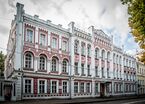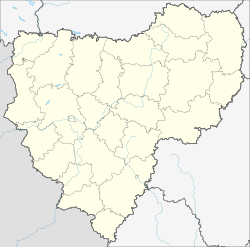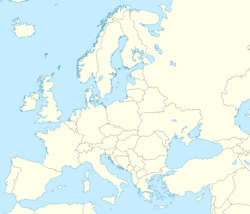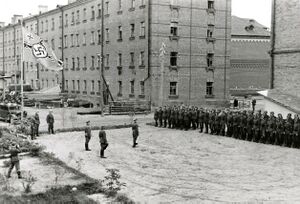سمولينسك
{{ safesubst:#invoke:Unsubst||date=__DATE__|$B=
سمولينسك
Смоленск | |
|---|---|
معرض الفن في سمولينسك | |
| الإحداثيات: 54°46′58″N 32°02′43″E / 54.78278°N 32.04528°E | |
| البلد | روسيا |
| الكيان الاتحادي | Smolensk Oblast[1] |
| Founded | Unknown (first mentioned in 863)[2] |
| الحكومة | |
| • الكيان | Smolensk City Council[3] |
| • Head | Andrew Borisov |
| المساحة | |
| • الإجمالي | 166٫35 كم² (64٫23 ميل²) |
| المنسوب | 254 m (833 ft) |
| التعداد | |
| • الإجمالي | 326٬861 |
| • Estimate (2018) | 330٬025 (+1%) |
| • الترتيب | 54th in 2010 |
| • الكثافة | 2٬000/km2 (5٬100/sq mi) |
| • Subordinated to | Smolensk Urban Okrug[1] |
| • Capital of | أوبلاست سمولينسك[1], Smolensky District[1] |
| • Urban okrug | سمولينسك، الأكروگ الحضري[6] |
| • Capital of | Smolensk Urban Okrug[6], Smolensky Municipal District[6] |
| منطقة التوقيت | UTC+ ([7]) |
| Postal code(s)[8] | 214ХХХ |
| Dialing code(s) | +7 4812 |
| OKTMO ID | 66701000001 |
| الموقع الإلكتروني | www |
سمولينسك (روسية: Смоленск; النطق الروسي: [smɐˈlʲɛnsk] (![]() استمع)؛ لتوانية: Smolenskas؛ إنگليزية: Smolensk) هي مدينة والمركز الإداري لأوبلاست سمولينسك، روسيا، تقع على نهر دنيپر، على بعد 360 كم غرب-جنوب غرب موسكو. بتعداد: 326,861 (تعداد 2010);[5] 325,137 (تعداد 2002);[9] 341,483 (تعداد 1989).[10]
استمع)؛ لتوانية: Smolenskas؛ إنگليزية: Smolensk) هي مدينة والمركز الإداري لأوبلاست سمولينسك، روسيا، تقع على نهر دنيپر، على بعد 360 كم غرب-جنوب غرب موسكو. بتعداد: 326,861 (تعداد 2010);[5] 325,137 (تعداد 2002);[9] 341,483 (تعداد 1989).[10]
The walled city in the center of Smolensk (along with the outskirts) was destroyed several times throughout its long history because it was on the invasion routes of both Napoleon and Hitler. Today, Smolensk is noted for electronics, textiles, food processing, and diamond faceting.
أصل الاسم
The name of the city is derived from the name of the Smolnya River. Smolnya river flows through Karelian and Murmansk areas of north-western Russia.[11] The origin of the river's name is less clear. أحد الاحتمالات هو الكلمة السلاڤية القديمة смоль (smol) for black soil, which might have colored the waters of the Smolnya. An alternative origin could be the Russian word смола (smola), which means resin, tar, or pitch. Pine trees grow in the area, and the city was once a center of resin processing and trade. The Byzantine emperor Constantine VII (r. 913–959) recorded its name as Μιλινισκα (Miliniska).[12]
الجغرافيا
The city is located in European Russia on the banks of the upper Dnieper River, which crosses the city within the Smolensk Upland, which is the western part of the Smolensk–Moscow Upland. The Dnieper River flows through the city from east to west and divides it into two parts: the northern (Zadneprove) and southern (center). داخل المدينة وبجوارها ينضم للنهر العديد من الروافد الصغيرة.
In the valleys are stretched streets, high ridges, hills, and headlands form the mountain. Smolensk is situated on seven hills (mountains). The old part of the city occupies the high, rugged left (south) bank of the Dnieper River. The area features undulating terrain, with a large number of tributaries, creeks and ravines.
التاريخ
الأصول بالعصور الوسطى
Smolensk is among the oldest Russian cities of the known Rus' era. The first recorded mention of the city was 863 AD, two years after the founding of Kievan Rus'. According to Russian Primary Chronicle, Smolensk (probably located slightly downstream, at the archaeological site of Gnezdovo) was located on the area settled by the East Slavic Radimichs tribe in 882 when Oleg of Novgorod took it in passing from Novgorod to Kiev. The town was first attested two decades earlier, when the Varangian chieftains Askold and Dir, while on their way to Kiev, decided against challenging Smolensk on account of its large size and population.
The first foreign writer to mention the city was the Byzantine Emperor Constantine Porphyrogenitus. في De Administrando Imperio (c. 950) he described Smolensk as a key station on the trade route from the Varangians to the Greeks. The Rus' people sailed from the Baltic region up the Western Dvina (Daugava) River as far as they could then they portaged their boats to the upper Dnieper. It was in Smolensk that they supposedly mended any leaks and small holes that might have appeared in their boats from being dragged on the ground and they used tar to do that, hence the city name.
The Principality of Smolensk was founded in 1054. Due to its central position in Kievan Rus', the city developed rapidly. By the end of the 12th century, the princedom was one of the strongest in Eastern Europe, so that Smolensk princes frequently controlled the Kievan throne. Numerous churches were built in the city at that time, including the church of Sts. Peter and Paul (1146, reconstructed to its presumed original appearance after World War II) and the church of St. John the Baptist (1180, also partly rebuilt). The most remarkable church in the city is called Svirskaya (1197, still standing); it was admired by contemporaries as the most beautiful structure east of Kiev.
Smolensk had its own veche since the very beginning of its history. Its power increased after the disintegration of Kievan Rus', and although it was not as strong as the veche in Novgorod, the princes had to take its opinion into consideration; several times in 12th and 13th centuries there was an open conflict between them.[13]
بين روسيا ولتوانيا وپولندا
Although spared by the Mongol armies in 1240, Smolensk paid tribute to the القبيل الذهبي, gradually becoming a pawn in the long struggle between Grand Duchy of Lithuania and the Grand Duchy of Moscow. The last sovereign monarch of Smolensk was Yury of Smolensk; during his reign the city was taken by Vytautas the Great of Lithuania on three occasions: in 1395, 1404, and 1408. After the city's incorporation into the Grand Duchy of Lithuania, some of Smolensk's boyars (e.g., the Sapiehas) moved to Vilnius; descendants of the ruling princes (e.g., the Tatishchevs, Kropotkins, Mussorgskys, Vyazemskys) fled to موسكو.
With tens of thousands of people living there, Smolensk was probably the largest city in 15th-century Lithuania.[بحاجة لمصدر] Three Smolensk regiments took part in the 1410 Battle of Grunwald (Tannenberg) against the Teutonic Knights. It was a severe blow to Lithuania when the city was taken by Vasily III of Russia in 1514. To commemorate this event, the Tsar founded the Novodevichy Convent in Moscow and dedicated it to the icon of Our Lady of Smolensk.
In order to repel future Polish–Lithuanian attacks, Boris Godunov made it his priority to heavily fortify the city. The stone kremlin constructed in 1597–1602 is the largest in Russia. It features thick walls and numerous watchtowers. Heavy fortifications did not prevent the fortress from being taken by the Polish–Lithuanian Commonwealth in 1611 after a long twenty-month siege, during the Time of Troubles and Dimitriads. Weakened Muscovy temporarily ceded Smolensk land to the Polish–Lithuanian Commonwealth in the Truce of Deulino. The city was granted Magdeburg rights in 1611 and was the seat of Smolensk Voivodeship for the next forty-three years.[14]
To recapture the city, the Tsardom of Russia launched the so-called "Smolensk War" against the Commonwealth in 1632. After a defeat at the hands of king Wladislaw IV, the city remained in Polish–Lithuanian hands. In 1632, the Uniate bishop Lew Kreuza built his apartments in Smolensk; they were later converted into the Eastern Orthodox Church of Saint Barbara. The hostilities resumed in 1654 when the Commonwealth was being affected by the Khmelnytsky Uprising and the Swedish deluge. After another siege, on September 23, 1654, Smolensk was recaptured by Russia. In the 1667 Truce of Andrusovo, the Polish–Lithuanian Commonwealth renounced its claims to Smolensk.
التاريخ الحديث

Smolensk has been a special place to Russians for many reasons, not least for the fact that the local cathedral housed one of the most venerated Orthodox icons, attributed to St. Luke. Building the new Cathedral of the Assumption was a great project which took more than a century to complete. Despite slowly sinking into an economic backwater, Smolensk was still valued by the Tsars as a key fortress defending the route to Moscow. It was made the seat of Smolensk Governorate in 1708.
In August 1812, two of the largest armies ever assembled clashed in Smolensk. During the hard-fought battle, described by Leo Tolstoy in War and Peace (Book Three Part Two Chapter 4), Napoleon entered the city. Total losses were estimated at 30,000 men. Apart from other military monuments, central Smolensk features the Eagles monument, unveiled in 1912 to mark the centenary of Napoleon's Russian campaign.
At the beginning of World War I, the 56th Smolensk Infantry Division was first assigned to the First Army of the Imperial Russian Army. They fought at the Battle of Tannenberg. It was subsequently transferred to the 10th Army and fought at the Second Battle of the Masurian Lakes. In March 1918, while the city remained part of Russia, the Belarusian People's Republic, proclaimed in Minsk under the German occupation, declared Smolensk part of it. In February–December 1918, Smolensk was home to the headquarters of the Western Front, North-West Oblast Bolshevik Committee and Western Oblast Executive Committee. On January 1, 1919, the Byelorussian Soviet Socialist Republic was proclaimed in Smolensk,[15] but its government moved to Minsk as soon as the German forces had been driven out of Minsk several days later.
الفترة السوڤيتية
After the Revolution, for inclusion in its composition as claimed Smolensk Belarusian People's Republic and the Byelorussian SSR.[مطلوب توضيح] Since April 1918 Smolensk was the center of the Western Region, which is based on January 1, 1919, Byelorussian SSR was formed. January 7 BSSR government moved to Minsk and Smolensk already January 16, 1919, decision of the Central Committee of the RCP Smolensk region was transferred to the RSFSR. In 1920 was held the new provincial census, according to which the Russian population prevailed over Belarus, but the Belarusian party leadership until 1926 left no hope for the inclusion of Smolensk in the Belorussian SSR. In 1940, 18 km (11 mi) from Smolensk, the Katyn Massacre occurred.
During World War II, Smolensk once again saw wide-scale fighting during the first Battle of Smolensk when the city was captured by the Germans on July 16, 1941. The first Soviet counteroffensive against the German army was launched in August 1941 but failed. However, the limited Soviet victories outside the city halted the German advance for a crucial two months, granting time to Moscow's defenders to prepare in earnest. Camp 126 was situated close to Smolensk and at this time Boris Menshagin was mayor of Smolensk, with his deputy Boris Bazilevsky. Both of them would be key witnesses in the Nuremberg Trials over the Katyn massacre.[16] Over 93% of the city was destroyed during the fighting; the ancient icon of Our Lady of Smolensk was lost. Nevertheless, it escaped total destruction. In late 1943, Göring [محل شك]had ordered Gotthard Heinrici to destroy Smolensk in accordance with the Nazi "scorched earth" policy. He refused and was punished for it. The city was finally liberated on September 25, 1943, during the second Battle of Smolensk. The rare title of Hero City was bestowed on Smolensk after the war.
After the Germans captured the city in 1941, they found the intact archives of Smolensk Oblast Committee of the Communist Party, the so-called Smolensk Archive. The archive was moved to Germany, and a significant part of it eventually ended up in the United States, providing Western scholars and intelligence specialists with unique information on the local workings of the Soviet government during its first two decades. The archives were returned to Russia by the United States in 2002.[17][18]
الأحداث الأخيرة
في 10 أبريل 2010، سقطت نفاثة عسكرية من طراز تو-154 تقل الرئيس الپولندي لخ كاتشينسكي، وزوجته والعديد من الشخصيات السياسية والعسكرية البارزة في منطقة غابات بالقرب من سمولينسك أثنا اقترابها من مطار عسكري محلي. لقي جميع الركاب مصرعهم على الفور بمجرد ارتطام الطائرة بالأرض. غرض الزيارة كان إحياء الذكرى السبعين لـمذبحة كاتين، التي راح ضحيتها نحو 22,000 أسير پولندي على يد NKVD.
في 2013، اكتشف علماء آثار من أكاديمية العلوم الروسية وأزالوا التراب عن معابد قديمة في سمولنسك تعود إلى منتصف أو أواخر القرن 12 الميلادي، بُنيت على الضفة اليسرى لما كانت آنذاك العاصمة بلدية سمولينسك. From unique object preserved walls in some places low, in others the height of human growth.[19]
In September 2013, Smolensk widely celebrated the 1,150th anniversary with funds spent on different construction and renovation projects in the city.[20] In celebration the Central Bank of Russia issued commemorative coins made of precious metals.[21]
المناخ
| بيانات المناخ لـ سمولينسك | |||||||||||||
|---|---|---|---|---|---|---|---|---|---|---|---|---|---|
| الشهر | ينا | فب | مار | أبر | ماي | يون | يول | أغس | سبت | أكت | نوف | ديس | السنة |
| القصوى القياسية °س (°ف) | 9.3 (48.7) |
9.0 (48.2) |
19.4 (66.9) |
28.0 (82.4) |
30.1 (86.2) |
31.2 (88.2) |
34.5 (94.1) |
37.2 (99.0) |
29.5 (85.1) |
24.8 (76.6) |
14.6 (58.3) |
9.8 (49.6) |
37.2 (99.0) |
| متوسط القصوى اليومية °س (°ف) | −3.8 (25.2) |
−3.4 (25.9) |
2.1 (35.8) |
11.2 (52.2) |
18.0 (64.4) |
21.0 (69.8) |
23.1 (73.6) |
21.7 (71.1) |
15.8 (60.4) |
9.0 (48.2) |
1.3 (34.3) |
−2.8 (27.0) |
9.4 (48.9) |
| المتوسط اليومي °س (°ف) | −6.2 (20.8) |
−6.4 (20.5) |
−1.4 (29.5) |
6.3 (43.3) |
12.5 (54.5) |
15.8 (60.4) |
17.8 (64.0) |
16.3 (61.3) |
10.9 (51.6) |
5.3 (41.5) |
−0.9 (30.4) |
−5.1 (22.8) |
5.4 (41.7) |
| متوسط الدنيا اليومية °س (°ف) | −8.9 (16.0) |
−9.6 (14.7) |
−4.9 (23.2) |
1.9 (35.4) |
7.3 (45.1) |
10.9 (51.6) |
12.9 (55.2) |
11.5 (52.7) |
6.7 (44.1) |
2.2 (36.0) |
−3.2 (26.2) |
−7.6 (18.3) |
1.6 (34.9) |
| الصغرى القياسية °س (°ف) | −37.9 (−36.2) |
−36.8 (−34.2) |
−28.1 (−18.6) |
−19.8 (−3.6) |
−5.4 (22.3) |
−0.7 (30.7) |
4.4 (39.9) |
0.3 (32.5) |
−4.4 (24.1) |
−12.8 (9.0) |
−24.8 (−12.6) |
−35.2 (−31.4) |
−37.9 (−36.2) |
| متوسط تساقط الأمطار mm (inches) | 48 (1.9) |
42 (1.7) |
42 (1.7) |
38 (1.5) |
61 (2.4) |
87 (3.4) |
90 (3.5) |
85 (3.3) |
70 (2.8) |
66 (2.6) |
58 (2.3) |
51 (2.0) |
738 (29.1) |
| Average rainy days | 9 | 8 | 10 | 15 | 17 | 18 | 16 | 16 | 16 | 18 | 15 | 11 | 169 |
| متوسط الرطوبة النسبية (%) | 87 | 84 | 78 | 69 | 69 | 75 | 77 | 79 | 83 | 85 | 89 | 89 | 80 |
| Mean monthly ساعات سطوع الشمس | 47 | 75 | 123 | 178 | 249 | 271 | 259 | 231 | 156 | 91 | 35 | 24 | 1٬739 |
| Source 1: Pogoda.ru.net[22] | |||||||||||||
| Source 2: NOAA (sun, 1961–1990)[23] | |||||||||||||
الاقتصاد
Smolensk has several factories including the Smolensk Aviation Plant and several electronics and agricultural machinery factories.
البلدات التوأم – المدن الشقيقة
Smolensk is twinned with:[24][25]
 كولورادو سپرنگز، الولايات المتحدة (1993)
كولورادو سپرنگز، الولايات المتحدة (1993) هاگن، ألمانيا (1985)
هاگن، ألمانيا (1985) كرچ، أوكرانيا (2000)
كرچ، أوكرانيا (2000) كراگويڤاتس، صربيا (2009)
كراگويڤاتس، صربيا (2009) ترگوڤيشته، بلغاريا (2002)
ترگوڤيشته، بلغاريا (2002) Tulle، فرنسا (1981)
Tulle، فرنسا (1981) ڤيتبسك، بلاروس
ڤيتبسك، بلاروس
التكريم
Smolensk Strait between Livingston Island and Deception Island in the South Shetland Islands, Antarctica is named after the city.[26]
انظر أيضاً
المراجع
الهامش
- ^ أ ب ت ث ج خطأ استشهاد: وسم
<ref>غير صحيح؛ لا نص تم توفيره للمراجع المسماةRef138 - ^ Историческая справка
- ^ "Смоленский городской Совет - Официальный сайт органа местного самоуправления". www.smolsovet.ru.
- ^ "Результат запроса". www.gks.ru.
- ^ أ ب Russian Federal State Statistics Service (2011). "Всероссийская перепись населения 2010 года. Том 1". Всероссийская перепись населения 2010 года (2010 All-Russia Population Census) (in Russian). Federal State Statistics Service. Retrieved June 29, 2012.
{{cite web}}: Invalid|ref=harv(help); Unknown parameter|trans_title=ignored (|trans-title=suggested) (help)CS1 maint: unrecognized language (link) - ^ أ ب ت خطأ استشهاد: وسم
<ref>غير صحيح؛ لا نص تم توفيره للمراجع المسماةRef223 - ^ "Об исчислении времени". Официальный интернет-портал правовой информации (in Russian). 3 June 2011. Retrieved 19 January 2019.
{{cite web}}: CS1 maint: unrecognized language (link) - ^ Почта России. Информационно-вычислительный центр ОАСУ РПО. (Russian Post). Поиск объектов почтовой связи (Postal Objects Search) (in روسية)
- ^ Федеральная служба государственной статистики (Federal State Statistics Service) (2004-05-21). "Численность населения России, субъектов Российской Федерации в составе федеральных округов, районов, городских поселений, сельских населённых пунктов – районных центров и сельских населённых пунктов с населением 3 тысячи и более человек[[Category:Articles containing روسية-language text]] (Population of Russia, its federal districts, federal subjects, districts, urban localities, rural localities—administrative centers, and rural localities with population of over 3,000)". Всероссийская перепись населения 2002 года (All-Russia Population Census of 2002) (in Russian). Federal State Statistics Service. Retrieved 2008-07-25.
{{cite web}}: URL–wikilink conflict (help)CS1 maint: unrecognized language (link) - ^ "Всесоюзная перепись населения 1989 г. Численность наличного населения союзных и автономных республик, автономных областей и округов, краёв, областей, районов, городских поселений и сёл-райцентров.[[Category:Articles containing روسية-language text]] (All Union Population Census of 1989. Present population of union and autonomous republics, autonomous oblasts and okrugs, krais, oblasts, districts, urban settlements, and villages serving as district administrative centers.)". Всесоюзная перепись населения 1989 года (All-Union Population Census of 1989) (in Russian). Demoscope Weekly (website of the Institute of Demographics of the State University—Higher School of Economics. 1989. Retrieved 2007-12-13.
{{cite web}}: Italic or bold markup not allowed in:|publisher=(help); URL–wikilink conflict (help)CS1 maint: unrecognized language (link) - ^ "Государственный водный реестр: река Смольная". textual.ru. Retrieved 2022-02-13.
- ^ Paul Stephenson (21 April 2000). "Byzantine Relations with Northern Peoples in the Tenth Century" (PDF).
- ^ Алексеев, Л. В. (1980). Смоленская земля в IX-XIII вв (in الروسية). Moscow: Наука. pp. 111–115.
- ^ Никитин, Павел (1848). История города Смоленска. Moscow: Типография Селивановского. p. 171.
- ^ Marples, D. (2016). Belarus: From Soviet Rule to Nuclear Catastrophe. Springer. p. 11. ISBN 978-0230378315.
- ^ Sanford, George. Katyn and the Soviet Massacre of 1940: Truth, Justice and Memory, Part 804, 2005, p. 140. ISBN 978-0-415-33873-8.
- ^ [1] Archived يناير 29, 2008 at the Wayback Machine
- ^ "Prologue: Selected Articles". Archives.gov. 2011-10-19. Retrieved 2011-12-24.
- ^ "Интерфакс-Религия: Археологи обнаружили в Смоленске храм XII века". www.interfax-religion.ru.
- ^ 1150-летие Смоленска: от проектов к реализации Archived أبريل 15, 2014 at the Wayback Machine
- ^ "К 1150-летию основания Смоленска отчеканили памятные монеты из драгоценных металлов". www.35kopeek.ru.
- ^ "Weather and Climate-The Climate of Somlensk" (in Russian). Weather and Climate (Погода и климат). Retrieved 11 April 2016.
{{cite web}}: CS1 maint: unrecognized language (link) - ^ "Smolensk Climate Normals 1961–1990". National Oceanic and Atmospheric Administration. Retrieved 11 April 2016.
- ^ "Города-побратимы". smoladmin.ru (in الروسية). Smolensk. Retrieved 2020-12-21.
- ^ "Colorado Springs Sister Cities International". coloradosprings.gov. City of Colorado Springs. April 30, 2018. Retrieved 2020-12-21.
- ^ Smolensk Strait. SCAR Composite Antarctic Gazetteer.
المصادر
ببليوجرافيا
- See also: Bibliography of the history of Smolensk
وصلات خارجية
- (بالروسية) Official website of Smolensk
- (بالروسية) Travel in Smolensk
- (بالروسية) Smolensk news
- (بالروسية) Smolensk Wiki
- (بالروسية) Homepage of the Smolensk fortress
- Some photos of the Smolensk fortress
- More photos of Smolensk
- Historic images of Smolensk
- (بالروسية) Basketball in Smolensk
- (بالروسية) News of Smolensk sport
- (بالروسية) News of Smolensk medicine
- The murder of the Jews of Smolensk during World War II, at Yad Vashem website.
- Pages using gadget WikiMiniAtlas
- CS1 errors: unsupported parameter
- Articles with روسية-language sources (ru)
- Articles containing روسية-language text
- CS1 errors: URL–wikilink conflict
- CS1 errors: markup
- CS1 الروسية-language sources (ru)
- Short description is different from Wikidata
- Missing redirects
- Pages using multiple image with auto scaled images
- Coordinates on Wikidata
- Pages using infobox settlement with image map1 but not image map
- Articles containing لتوانية-language text
- Pages using Lang-xx templates
- Articles containing إنگليزية-language text
- Articles with text in Slavic languages
- Articles containing Ancient Greek (to 1453)-language text
- Articles with unsourced statements from October 2020
- جميع الصفحات التي تحتاج تنظيف
- مقالات بالمعرفة تحتاج توضيح from September 2016
- مقالات ذات عبارات محل شك
- سمولنسك
- محافظة سمولنسك
- ڤويڤودية سمولنسك
- حصون روسيا
- Portages
- صفحات مع الخرائط

















